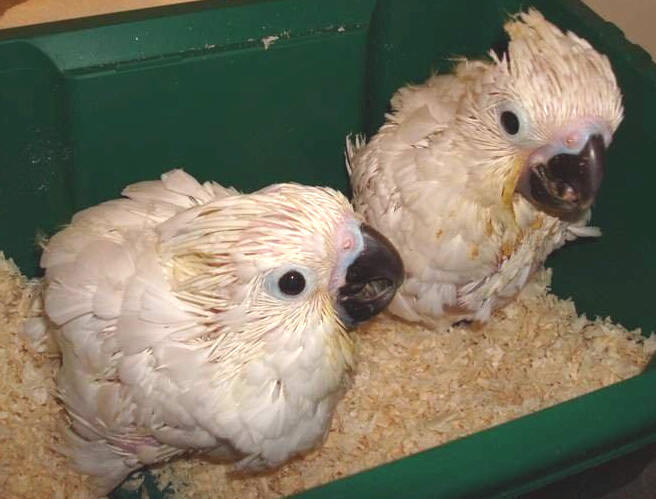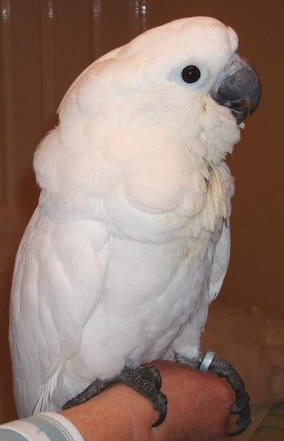|
 |
BREEDS
& THEIR NEEDS
UMBRELLA
COCKATOO
(Cacatua Alba)
 
This article was submitted by Club
Member Janette - Many Thanks to her.
|
 |
The
pictures are "Thumbnails" - click on pictures inc. the one at the
top of the page and you will see a bigger picture.
Press the
"Back" button to return to this page
DESCRIPTION
White with a broad crest. The underside of tail and wings are yellow. Bill- blackish-horn colour. Eyes black (reddish-brown iris in a mature female)
Length 45cm (18ins)
SEXING
The Birds' are dimorphic (i.e. look the same or very
similar). Or by the Adult bird's eyes once they reach about two+ years old. Female will have reddish-brown iris. Male the eyes are jet black. Mature female has a smaller head and beak
than the male.
GENERAL INFO
Umbrellas aren't particularly good at talking. As a pet they need loads of constant attention. Not a bird to be left on it's own all day - so if you work, this
is not the bird for you! They call them the "Velcro Bird" and that's exactly what
they are like, very clingy. Very loving but unpredictable when in "Breeding
Mode".
NOT for the beginner
Breeder/ Bird-keeper or as a "First Pet Bird"!
They love to bathe. It's lovely to watch them upside down
with wings spread out
when there's a rain shower.
DISTRIBUTION
HABITAT
AVICULTURE
Fairly noisy bird, initially shy. Quite a destructive bird, thin mesh is a Big "No No" with these birds, they can
chew thru. almost anything. Double, heavy-guage, parrot-proof wiring a must. Esp. if you have other birds in an adjoining Aviary.
ACCOMMODATION
Ideally, provide a spacious flight with shelter - 18 x 6 x 6 ft is
an appropriate size. Clean shavings and pieces of wood for them to chew are adequate for the
nest box.
DIET
Good quality Parrot
seed mix - not too many sunflower seeds. They love monkey nuts. Walnuts are a special favourite but have to be halved for them, as they
don't seem to be able to crack them open too well. Fruit and vegetables, love sweetcorn, peas and grated carrot mixed
with egg food.
A calcium supplement, Daily essentials 3 + a Pro-biotic
once a week.
Worming
x2 per year - spring b4 Breeding Season and Autumn after
Breeding Season finished
to prepare them for winter.
BREEDING
Usually begins in spring but can occur at other times of the year. Breeding age starts around 4 - 5 years old. Hard wood nest box as ply wood won't last very long! A substantial Nest box size : approx.15" square 30" high. Clean shavings and pieces of wood for them to chew are adequate for them
to create their own
nest box base-bedding. Chewing the wood helps to stimulate them into
"Breeding mode".
CLUTCH : is normally two eggs. Both birds sit the eggs in turn and both parents feed the chicks. Although, some do take longer to wean, they will beg for food for ages
after they really need it. So, it's really a case of playing things by ear to make sure the babies
don't suffer, physically or mentally. They should never move to a new home until they are fully independent.
Incubation - 28 days
Chicks Fledge - Around 14 weeks but still continue to be fed by the parents for weeks
afterwards.
First moult - Around
12 - 18 months old.
RINGING
HAND-REARING
Some Captive-bred, domesticated Umbrellas don't
sit their eggs well and if this is the case then it's best if the eggs are
removed and put in Incubators. Some will sit and hatch the chicks but tend just
to feed one of the chicks and the other one is left to
starve and
eventually die. Here is where Nest box cameras can help identify the
problem before the either chick gets to stage
where it is beyond help. It must then be removed (carefully & safely)
then hand-reared. Rarely, altho. it can happen, the parents manage
to successfully rear
both chicks. Often they may feed them happily and regularly up to 2 weeks
but often
not past 3 weeks. Keeping a close eye on them is the key and if the
parents start leaving the Nest box for extended periods,
it's best to
remove the chicks and hand-rear, as they can easily get chilled,
esp. if
the weather is cold and they don't have their parents to keep them warm. If a chick becomes
chilled, it's metabolism slows down and it's feed response suffers
It's a catch 22 situation - this is why it's best
to remove the chick(s). Make sure you warm the chick(s) through by putting
it in a pre-heated Brooder. This will help save it's life and also speed up
it's metabolic rate to help kick-start it's "feed response"
when
you start to feed it. Some breeders are lucky and do have Umbrella pairs that will parent-raise
their chicks.
A hand-reared baby would be ready at around
sixteen weeks old to go to a new home.
^Top

|